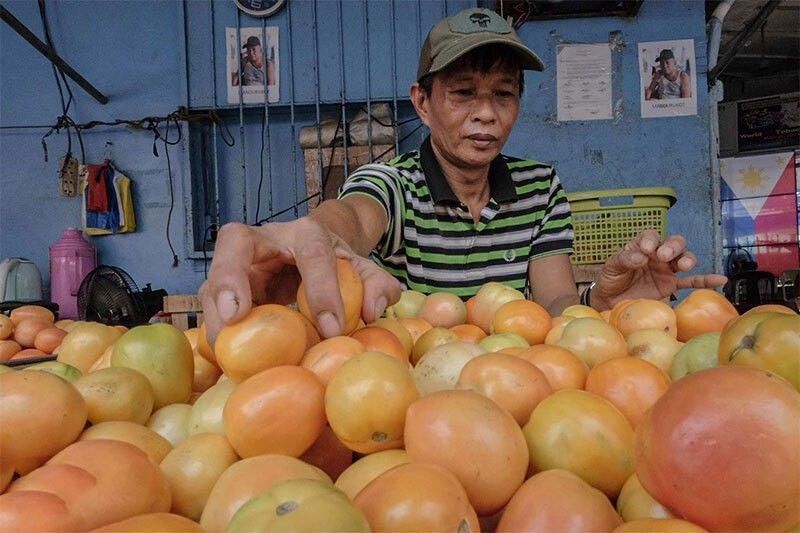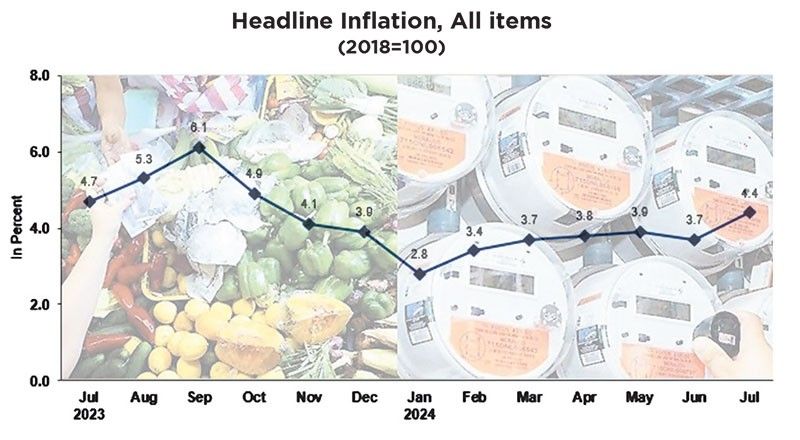Inflation quickens to 4.4% in July

Highest since October 2023
MANILA, Philippines — Inflation in July accelerated to 4.4 percent, its highest level this year, from 3.7 percent in June, due mainly to faster increases in utility and food costs, according to the Philippine Statistics Authority (PSA).
The July headline inflation, or rate of increase in average prices of goods and services typically being bought by consumers, was the fastest since the 4.9 percent recorded in October last year, but lower than the 4.7 percent in July last year.
While the latest inflation print is within the Bangko Sentral ng Pilipinas’ four to 4.8 percent forecast for the month, it breached the government’s two to four percent target for the year.
National Statistician Dennis Mapa said in a press conference yesterday that the uptrend in overall inflation was due to the higher growth posted by the housing, water, electricity, gas and other fuels commodity group at 2.3 percent in July from 0.1 percent in June.
Also cited as a major driver of the acceleration was the food and non-alcoholic beverages commodity group, which rose to 6.4 percent in July from 6.1 percent in June.
Food inflation picked up to 6.7 percent in July from 6.5 percent in June. This was due mainly to the faster uptick in meat and other parts of slaughtered land animals at 4.8 percent from the previous month’s 3.1 percent, and in fruits and nuts to 8.4 percent from 5.6 percent in the prior month.
Rice inflation slowed to 20.9 percent in July from June’s 22.5 percent.
Mapa said average rice prices declined in July from the previous month, although the reductions were not that substantial.
He said the average price of regular milled rice decreased to P50.90 per kilogram in July from P51.10 per kg in June.
The average price of well-milled rice also went down to P55.85 per kg in July from P55.96 per kg in June.
As for special rice, the average price declined to P64.42 per kg in July from the previous month’s P64.56 per kg.
Mapa said it is possible for rice inflation to ease and be slower than 20 percent in August, citing the impact of the lowered tariffs on imports of the staple and last year’s high base.
“Definitely, there will be adjustments in terms of rice inflation simply because in August 2023, the base was high,” he said.
Rice inflation rose to 8.7 percent in August last from 4.2 percent in July 2023.
Core inflation, which excludes volatile food and energy items, slowed down to 2.9 percent in July from the previous month’s 3.1 percent.

For the January to July period, inflation averaged 3.7 percent.
Moody’s Analytics economist Sarah Tan said in an email that July inflation is seen as the peak, with inflation expected to ease in the coming months.
“Much of the moderation will come from the food category, which accounts for the largest share in the CPI (consumer price index) basket,” she said, noting that the impact from Super Typhoon Carina could show up in the inflation prints in the coming months after the 60-day price freeze on basic necessities imposed last July 24 ends.
She said lower import tariffs on rice would also help cushion the pain from the typhoon.
The National Economic and Development Authority (NEDA) said the government is implementing crucial interventions to support the most vulnerable sectors and ensure food security.
“The government is relentlessly working to address our nation’s most pressing concern of ensuring food security for every Filipino amid the faster rise in prices in July and the expected typhoons and rains due to the onset of La Niña this August,” NEDA Secretary Arsenio Balisacan said.
Among the measures being undertaken is to assist farmers dealing with higher fuel prices, through around P510 million worth of subsidies to be provided by the Department of Agriculture to around 160,000 farmers between August and September.
The Department of Finance (DOF) maintained that the inflation uptick last month is temporary and is expected to ease anew as the impact of the rice tariff cut becomes more pronounced.
Finance Secretary Ralph Recto said the headline rate is likely a one-time uptick due to high base effects, particularly in the price of rice.
Despite the uptick, Recto said inflation will temper and fall within target for the rest of the year as government interventions take full effect.
“The impact of government interventions, particularly the reduced rice tariffs, will be more pronounced starting this August,” Recto said.
“Although, we might see slight increases in vegetable prices due to damages brought by typhoon Carina in the agriculture sector,” he said.
Data showed that local retail prices of rice only gradually decreased in July as traders are still unloading their inventories, which were initially purchased at high prices prior to the implementation of Executive Order 62.
EO 62 slashed rice tariff to 15 percent from 35 percent in a bid to tame inflation.
“Decline in retail prices of rice will become more apparent in the coming months as the volume of rice imports at lower tariff is anticipated to increase and augment local supply,” Recto said.
Apart from rice, the DOF is also expecting that the ban on Philippine offshore gaming operators will lower the demand for housing rentals and office spaces, thereby helping temper rental prices. — Louise Maureen Simeon
- Latest
- Trending




























